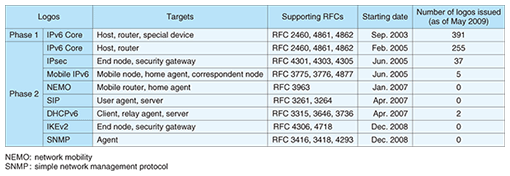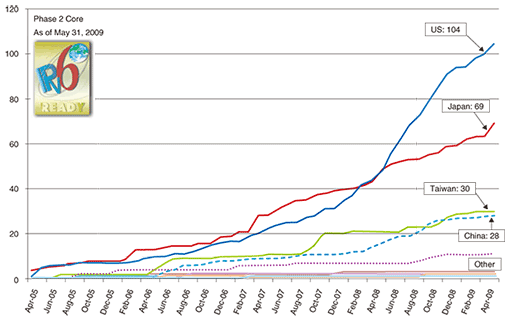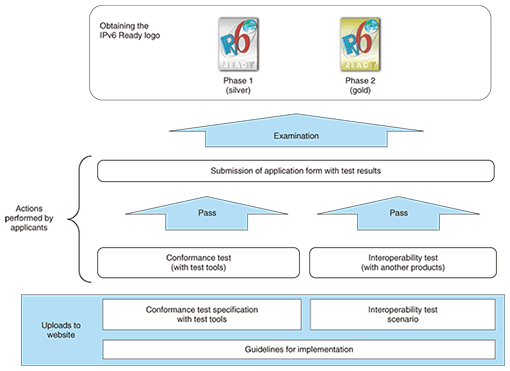 |
|||||||||||||||||
|
|
|||||||||||||||||
|
Global Standardization Activities Vol. 7, No. 12, pp. 51–56, Dec. 2009. https://doi.org/10.53829/ntr200912gls Activities of IPv6 Ready Logo ProgramAbstractWe introduce the global certification program °»IPv6 Ready Logo Program°…, which aims to enhance the interoperability of IPv6 (Internet protocol version 6) products in preparation for the prevalence of IPv6. Telecommunications carriers, Internet service providers, and enterprises have recently started to migrate from IPv4 to IPv6, which has led to a growing number of IPv6 products. Most of them are compliant with the IPv6 specification released as IETF RFCs (Internet Engineering Task Force Requests For Comments). However, even if they are RFC-compliant, there could still be various implementations, which could lead to poor interoperability.
1. IntroductionMany network products are compliant with IPv6 these days. Specifications for IPv6 (Internet protocol version 6) were standardized at IETF (Internet Engineering Task Force) and published in the form of RFCs (Request For Comments). However, even if products are developed in accordance with the RFCs, the rules for functions might not be prescribed in detail, so there could be many implementations based on various different interpretations. This might result in IPv6 products being unable to connect with each other, which would constrain the useful IPv6 services. The °»IPv6 Ready Logo Program°… [1] is intended to set minimum standards for interoperability and to guarantee them in order to promote an environment where users can select IPv6 products without anxiety. 2. Program overviewThe IPv6 Forum is an international not-for-profit organization (NPO) that aims to support IPv6 prevalence. The IPv6 Ready Logo Program is an IPv6 product certification program operated by the Forum°«s IPv6 Ready Logo Committee (v6LC). The IPv6 Ready logo can be issued for IPv6 products that meet certain standards. To qualify for the logo, a product must pass both a conformance test and an interoperability test (described in detail later). Interoperability between products given the logo is guaranteed. 3. Global cooperative structureDetailed implementation specifications and test items for the program are being developed through global cooperation (Fig. 1). UNH-IOL in the USA, IRISA in Europe, BII in China, NICI in Taiwan, TTA in South Korea, and v6PC and JATE in Japan are charged with developing them.
In Japan, the Certification Working Group (Certification WG) under the IPv6 Promotion Council (v6PC) [2] is charged with developing the specifications and test items. This WG has five sub-WGs: Core, IPsec, MIPv6, SIP, and DHCPv6 (IPsec: Internet protocol security, MIPv6: mobile IPv6, SIP: session initiation protocol, and DHCP: dynamic host control protocol). They make conformance test specifications, interoperability test scenarios, and conformance test tools for performing conformance tests for these corresponding areas. Japan has made major contributions to the logo program. As described later, the specifications of IPv6 Core protocols in both phase 1 and phase 2 and the IPsec, Mobile IPv6, and IKEv2 (Internet key exchange) protocols in phase 2 were introduced to the logo program by Japanese contributions. The test results are also examined through global cooperation. In Japan, JATE (Japan Approvals Institute for Telecommunications Equipment) [3] started to operate the °»Japan IPv6 Certification Center°… and is charged with examining test results. Although enquiries about the logo program are handled in English and the program°«s website is in English, JATE is aimed at supporting enquires from Japanese people and its website promotes logo acquisition in Japan, so it is only in Japanese. 4. Logo lineupThere are currently two types of logos in the program: the °»phase 1 logo°… covers required functions for interoperability and the series of °»phase 2 logos°… covers extended functions beyond phase 1 (Table 1).
4.1 Phase 1 logoThe range of the phase 1 logo is restricted to the Core protocol, which is indispensable for interoperability between IPv6 products. The Core protocol includes NDP (neighbor discovery protocol), stateless address configuration, and ICMP (Internet control message protocol). Target products are not only end nodes and routers but also special products that can be used for only limited purposes. After a phase 1 logo has been obtained, the silver logo mark will be provided. The number of phase 1 logos issued as of May 31, 2009 was 391. However, since v6LC recommends trying to obtain phase 2 logos rather than phase 1 ones so as to guarantee high interoperability widely, phase 2 Core logos currently have a much faster acquisition rate than phase 1 logos. 4.2 Phase 2 logosWhile the phase 1 logo aims to guarantee minimum interoperability, the phase 2 logos are intended for products assumed to be applied to real network environments. Therefore, the targets of phase 2 include various functions: not only the Core protocol, but also IPsec, Mobile IPv6, NEMO, SIP, DHCPv6, IKEv2, and SNMP (NEMO: network mobility, SNMP: simple network management protocol). The phase 2 Core protocol has advanced functions used in actual operations in addition to the phase 1 Core protocol functions. However, it is important to note that when obtaining the logos for extended functions such as IPsec, Mobile IPv6, and IKEv2, one must obtain not only the logo for the specific function (IPsec, Mobile IPv6, etc.), but also the logo for the phase 2 Core protocol. After a phase 2 logo has been obtained, a gold logo mark will be provided. As of May 31, 2009, the numbers of issued phase 2 logos were 255 for the Core protocol, 37 for IPsec, 5 for Mobile IPv6, and 2 for DHCPv6. In August 2008, the National Institute of Standards and Technologies (NIST) of the USA released °»A Profile for IPv6 in the U.S. Government ver. 1.0°…. This profile is based on the IPv6 Ready Logo Program specifications. That is why the number of phase 2 logos acquired in the USA has grown remarkably (Fig. 2).
5. Specification release procedureThis section describes the procedure for releasing the specifications for a logo. First, the target protocol for the logo is proposed by a cooperative organization in one of the member countries at the technical meeting held by v6LC. After this proposal has been accepted by the v6LC board members, the proposer starts to make proposal documents. These documents include °»Guidelines for Implementation and Priorities in Testing°… (hereinafter called °»Implementation Guidelines°… ), °»Conformance Test Specifications°…, and °»Interoperability Test Scenario°…. After their submission, an internal review of them is conducted. Then a public review is conducted. Since anyone can comment on the documents and the test tools at the public review, the public review°«s output benefits from the opinions of many knowledgeable persons such as IETF experts and IPv6 product developers. If, after the review, the v6LC board members judge that there is no problem, the program for that logo can start with global consensus. Although the use of a specific conformance test tool is not specified, a suitable tool is often released at the same time as the specifications. 6. Document release procedure and test procedureThe Guidelines for Implementation, Conformance Test Specification, and Interoperability Test Scenario are released on the IPv6 Ready Logo Program website. Applicants can follow these documents and perform tests by themselves. 6.1 Guidelines for ImplementationIn order to make test items, one needs guidelines for their standards. This is the °»Guidelines for Implementation°…. The document describes the required and optional functions as well as the target interfaces. These functions are derived from the relevant RFCs. In the case of two IPsec products being connected to each other, for example, if one supports only the 3DES-CBC encryption algorithm and the other supports only the DES-CBC encryption algorithm, they cannot connect to each other. Therefore, the minimum functions that products must support have to be defined as required functions. In accordance with these required and optional functions, two kinds of test items are defined: BASIC items and ADVANCED items. To get the logo, a product must pass at least all of the BASIC items. In v6LC, the creation of °»Guidelines for Implementations°… is left to the logo proposer. However, we think that the guidelines should be released so that applicants can see why each test item is needed. 6.2 Conformance Test SpecificationThe conformance test aims at validating a product in terms of whether or not it implements the functions required by the RFCs. Specifically, test conditions, sequences, packets to be sent or received, and expected operations are defined for each test item in the specifications. This test is accomplished through specific test tools, which emulate a reference environment for the product being tested. As described earlier, the test specifications must be authorized by v6LC, but test tools are released freely as they are developed by cooperating organizations in various countries. We expect that these test tools will be used not only for logo acquisition activities but also for IPv6 product debugging work. This will promote the spread of IPv6 products throughout the world. 6.3 Interoperability Test ScenarioThe interoperability test is a test of whether or not products can interact with other products of different origins. It is performed in an environment where the target product is connected with other products. The test scenario describes the purposes, conditions, and procedures of the test and the expected operations of the product. This test requires a connection between two different kinds of products of different origins. 7. Logo acquisition flowTo get the IPv6 Ready logo, applicants must first perform both the conformance test and the interoperability test and then submit an application form to v6LC with the test results [4]. There is a single application submission point to cover the whole world [5]. If the test results pass the global examination, applicants are issued with the logo (Fig. 3).
8. Testing laboratorySince April 2009, JATE has provided a testing laboratory [6] where the conformance and interoperability tests required for logo acquisition can be performed. It relieves users of the need to arrange the test environment, so it should lead to a big increase in the number of logos acquired in Japan. As of May 2009, the protocols supported by the laboratory are the Core protocol (phases 1 and 2), IPsec, and DHCPv6. However, JATE has said that other protocols will be supported in the near future. 9. Service logo programAlthough the IPv6 Ready Logo Program has targeted IPv6 products so far, v6LC started a logo program for IPv6 services on June 8, 2009 to promote the prevalence of IPv6 services. This program, called the °»IPv6 Enabled Program°… [7], provides two kinds of logo: WWW (World Wide Web) and ISP (Internet service providers). Getting the WWW logo requires the configuration of a global IPv6 address, registration with a DNS (domain name service) server on the Internet that has an AAAA record, and access using IPv6 HTTP (hypertext transfer protocol). It is available to both corporate entities and individuals operating web servers accessible via an IPv6 address. Having this WWW logo will enable a web server administrator to declare to website visitors that the web server is IPv6 compliant. Getting the ISP logo requires acquiring an IPv6 AS (autonomous system) number, the arrangement of IPv6 address blocks for assignment to users, and the capability to provide continuous IPv6 ISP services. Having this ISP logo will enable an ISP to publicize to the world that its Internet access service is IPv6 compliant. 10. Future of the logo programIMS (IP Multimedia Subsystem) and MLDv2 (multicast learner discovery) will also start logo programs before too long. Specifications and test items are now being made. The migration from IPv4 to IPv6 will be in full swing in the near future. We would like to get many product developers and service providers to use this logo program and to contribute strongly to the creation of an environment in which users can use IPv6 products safely and confidently. References
|
|||||||||||||||||















